CADILLAC ESCALADE ESV 2009 Owner's Guide
Manufacturer: CADILLAC, Model Year: 2009, Model line: ESCALADE ESV, Model: CADILLAC ESCALADE ESV 2009Pages: 602, PDF Size: 5.18 MB
Page 31 of 602
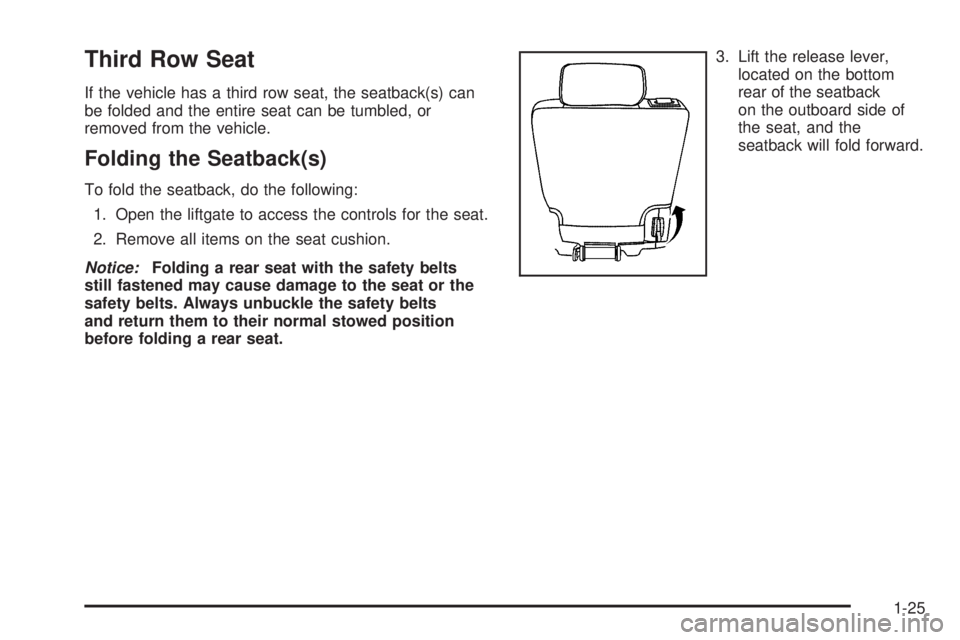
Third Row Seat If the vehicle has a third row seat, the seatback(s) can
be folded and the entire seat can be tumbled, or
removed from the vehicle.
Folding the Seatback(s) To fold the seatback, do the following:
1. Open the liftgate to access the controls for the seat.
2. Remove all items on the seat cushion.
Notice: Folding a rear seat with the safety belts
still fastened may cause damage to the seat or the
safety belts. Always unbuckle the safety belts
and return them to their normal stowed position
before folding a rear seat. 3. Lift the release lever,
located on the bottom
rear of the seatback
on the outboard side of
the seat, and the
seatback will fold forward.
1-25
Page 32 of 602

Unfolding the Seatback(s) To return the seatback to the upright position, do the
following:
1. Open the liftgate to access the controls for the seat.
2. Pull up on the seatback until it locks into the
upright position.
{ CAUTION: If either seatback is not locked, it could move
forward in a sudden stop or crash. That could
cause injury to the person sitting there. Always
push and pull on the seatbacks to be sure they
are locked.
3. Push and pull on the seatback to make sure it is
locked. Tumbling the Third Row Seat The seat can be tumbled forward for additional cargo
space.
To tumble the seat, do the following:
1. Open the liftgate to access the controls for the seat.
2. Make sure the head rests are completely lowered,
there is nothing under, in front of, or on the seat.
3. Fold the seatbacks forward using the instructions
previously listed under “Folding the Seatbacks”.
You will not be able to unlatch the seat from
the �oor unless the seatback is folded down.
4. Unlatch the seat from
the �oor by lifting the
lever located next
to the carrying handle
on the rear of the
seat near the bottom.
5. Lift the rear of the seat up from the �oor.
1-26
Page 33 of 602

6. Tilt the seat fully forward to lock it into place.
7. Push and pull on the seat to make sure it is locked.
Put the seat in this position only when necessary for
additional cargo space.
Returning the Third Row Seat from a
Tumbled Position To return the seat to the normal seating position, do the
following:
1. Open the liftgate to access the controls for the seat.
2. Make sure there is nothing that could become
trapped under the seat.
3. Release the seat from the tumbled position by lifting
the lever located next to the carrying handle at the
bottom rear of the seat.
4. Pull the seat down until it latches to the �oor. The
seatback cannot be raised if the seat is not latched
to the �oor.
5. Pull up on the seatback until it locks into the upright
position. { CAUTION: If either seatback is not locked, it could move
forward in a sudden stop or crash. That could
cause injury to the person sitting there. Always
push and pull on the seatbacks to be sure they
are locked.
6. Push and pull on the seatback to make sure it is
locked.
1-27
Page 34 of 602

Removing the Third Row Seat To remove the seat, do the following:
1. Open the liftgate to access the controls for the seat.
2. Fold the seatback forward using the instructions
listed under “Folding the Seatbacks” previously.
The seat cannot be removed unless the seatback is
folded.
3. Unlatch the seat from
the �oor by pulling the
carrying handle,
located at the rear of
the seat, rearward.
4. Roll the seat out of the vehicle. There is a track in
the �oor to guide the seat wheels out of the vehicle. Installing the Third Row Seat To install the seat, do the following:
1. Open the liftgate to access the rear of the vehicle.
2. Slide the front outboard seat wheels into the track on
the �oor and roll the seat forward. The front latches
should lock into place. If the latches do not lock, try
tilting the rear of the seat upward slightly.
3. Lower the rear of the seat and push down on the
seat to engage the rear �oor latches.
{ CAUTION: A seat that is not locked into place properly can
move around in a collision or sudden stop. People
in the vehicle could be injured. Be sure to lock the
seat into place properly when installing it.
4. Push and pull on the seat to make sure it is locked
into place. The seatback cannot be raised to the
upright position unless the seat is secured to
the �oor.
5. Pull up on the seatback until it locks into the upright
position.
1-28
Page 35 of 602
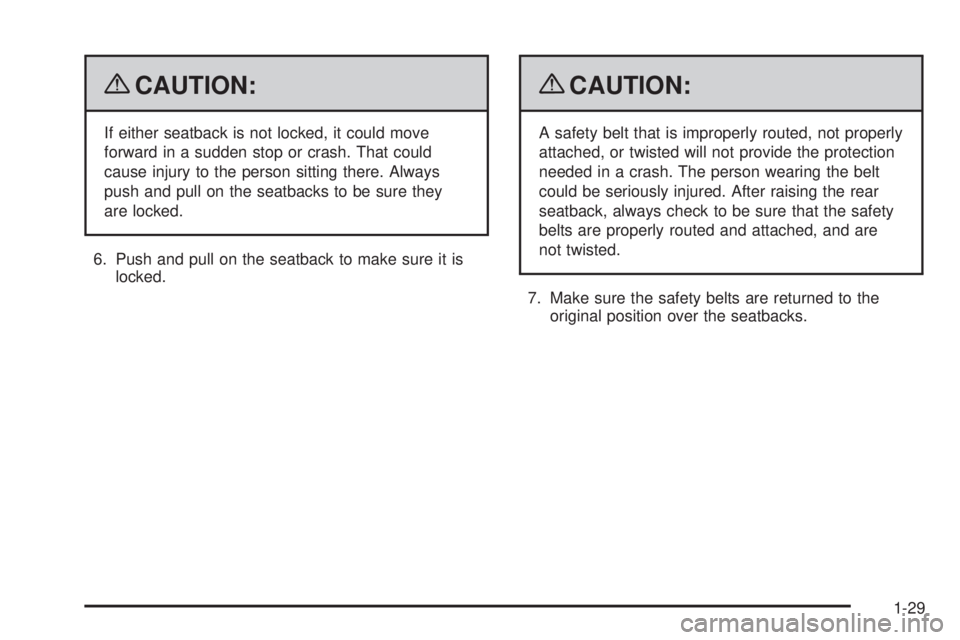
{ CAUTION: If either seatback is not locked, it could move
forward in a sudden stop or crash. That could
cause injury to the person sitting there. Always
push and pull on the seatbacks to be sure they
are locked.
6. Push and pull on the seatback to make sure it is
locked.
{ CAUTION: A safety belt that is improperly routed, not properly
attached, or twisted will not provide the protection
needed in a crash. The person wearing the belt
could be seriously injured. After raising the rear
seatback, always check to be sure that the safety
belts are properly routed and attached, and are
not twisted.
7. Make sure the safety belts are returned to the
original position over the seatbacks.
1-29
Page 36 of 602
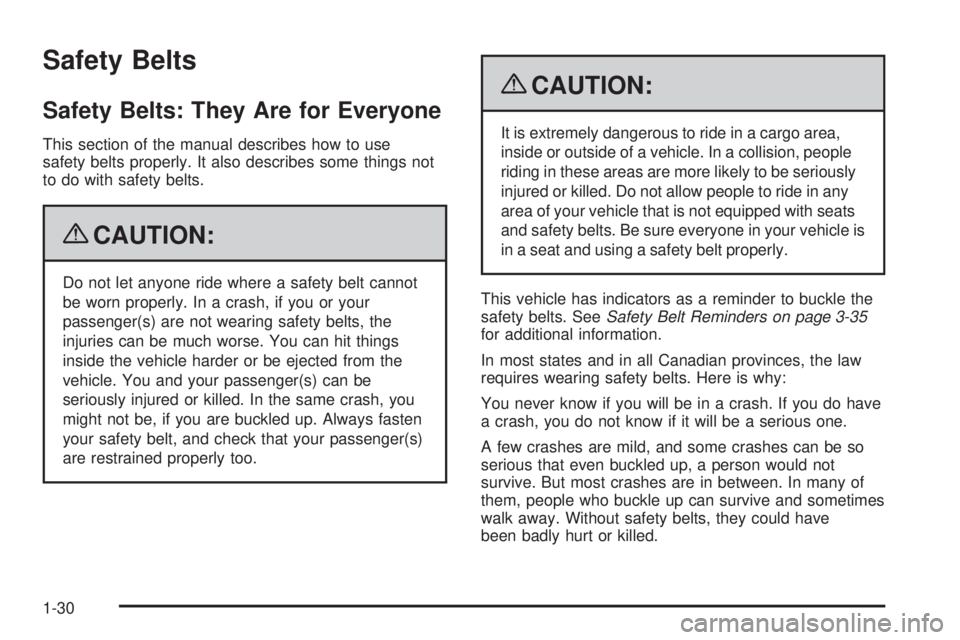
Safety Belts Safety Belts: They Are for Everyone This section of the manual describes how to use
safety belts properly. It also describes some things not
to do with safety belts.
{ CAUTION: Do not let anyone ride where a safety belt cannot
be worn properly. In a crash, if you or your
passenger(s) are not wearing safety belts, the
injuries can be much worse. You can hit things
inside the vehicle harder or be ejected from the
vehicle. You and your passenger(s) can be
seriously injured or killed. In the same crash, you
might not be, if you are buckled up. Always fasten
your safety belt, and check that your passenger(s)
are restrained properly too. { CAUTION: It is extremely dangerous to ride in a cargo area,
inside or outside of a vehicle. In a collision, people
riding in these areas are more likely to be seriously
injured or killed. Do not allow people to ride in any
area of your vehicle that is not equipped with seats
and safety belts. Be sure everyone in your vehicle is
in a seat and using a safety belt properly.
This vehicle has indicators as a reminder to buckle the
safety belts. See Safety Belt Reminders on page 3-35
for additional information.
In most states and in all Canadian provinces, the law
requires wearing safety belts. Here is why:
You never know if you will be in a crash. If you do have
a crash, you do not know if it will be a serious one.
A few crashes are mild, and some crashes can be so
serious that even buckled up, a person would not
survive. But most crashes are in between. In many of
them, people who buckle up can survive and sometimes
walk away. Without safety belts, they could have
been badly hurt or killed.
1-30
Page 37 of 602
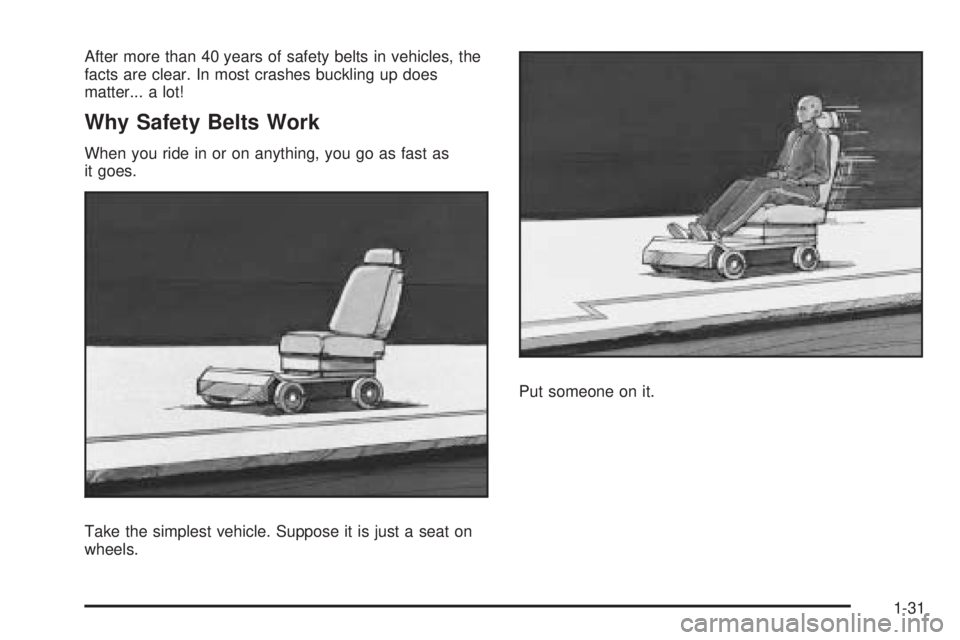
After more than 40 years of safety belts in vehicles, the
facts are clear. In most crashes buckling up does
matter... a lot!
Why Safety Belts Work When you ride in or on anything, you go as fast as
it goes.
Take the simplest vehicle. Suppose it is just a seat on
wheels. Put someone on it.
1-31
Page 38 of 602

Get it up to speed. Then stop the vehicle. The rider
does not stop. The person keeps going until stopped by something. In
a real vehicle, it could be the windshield...
1-32
Page 39 of 602
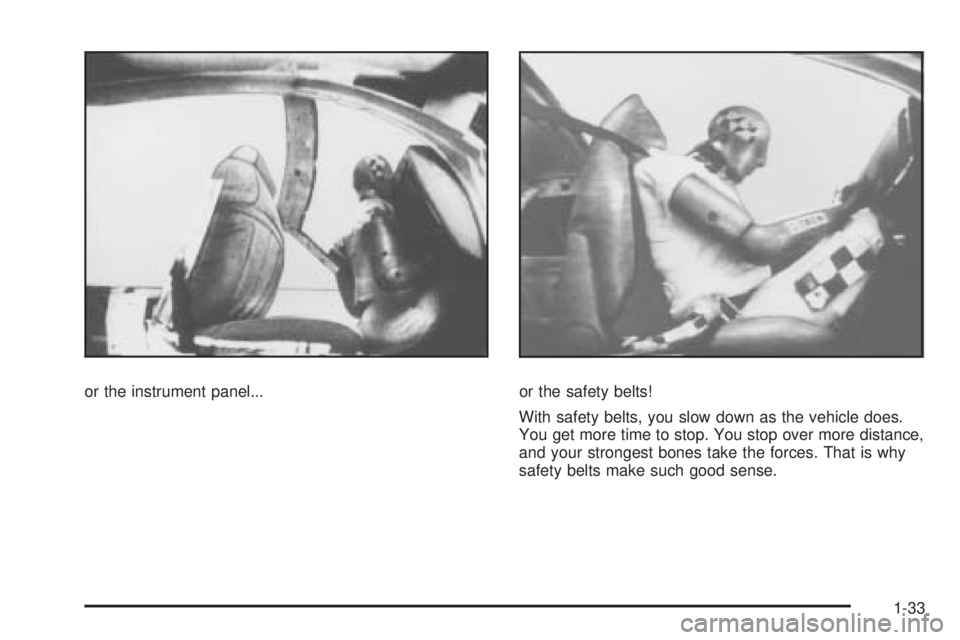
or the instrument panel... or the safety belts!
With safety belts, you slow down as the vehicle does.
You get more time to stop. You stop over more distance,
and your strongest bones take the forces. That is why
safety belts make such good sense.
1-33
Page 40 of 602
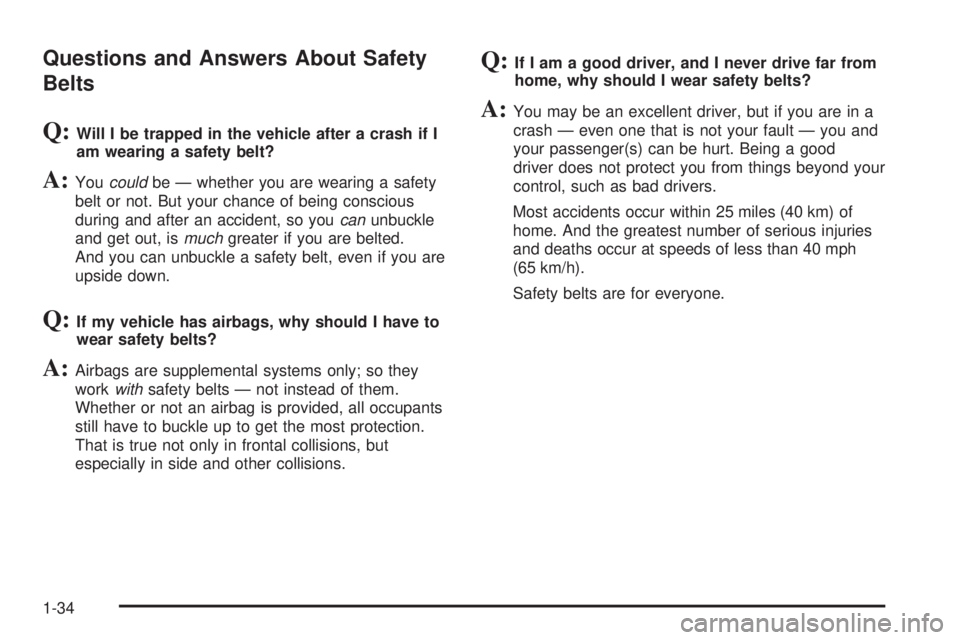
Questions and Answers About Safety
Belts
Q: Will I be trapped in the vehicle after a crash if I
am wearing a safety belt?
A: You could be — whether you are wearing a safety
belt or not. But your chance of being conscious
during and after an accident, so you can unbuckle
and get out, is much greater if you are belted.
And you can unbuckle a safety belt, even if you are
upside down.
Q: If my vehicle has airbags, why should I have to
wear safety belts?
A: Airbags are supplemental systems only; so they
work with safety belts — not instead of them.
Whether or not an airbag is provided, all occupants
still have to buckle up to get the most protection.
That is true not only in frontal collisions, but
especially in side and other collisions. Q: If I am a good driver, and I never drive far from
home, why should I wear safety belts?
A: You may be an excellent driver, but if you are in a
crash — even one that is not your fault — you and
your passenger(s) can be hurt. Being a good
driver does not protect you from things beyond your
control, such as bad drivers.
Most accidents occur within 25 miles (40 km) of
home. And the greatest number of serious injuries
and deaths occur at speeds of less than 40 mph
(65 km/h).
Safety belts are for everyone.
1-34